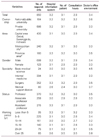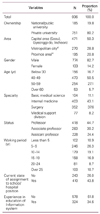Abstract
Figures and Tables
 | Figure 1The perception of the work itself. 1. It provides a lot of opportunities to acquire new knowledge or techniques. 2. It's an acknowledged and socially respected job. 3. It gives me intellectual stimulation and a sense of achievement. 4. It's pleasant and rewarding. 5. It affords a lot of opportunities to display one's own ability. 6. It requires a lot of time in clerical (administrative) transactions. 7. It gives me stress. 8. It makes me frustrated. 9. It's boring and gets me fed up. 10. It doesn't matter whether I work hard or just get by. A likert 5-point scale was used. |
 | Figure 2The perception of the working environment. 1. There is sufficient space for business activities. 2. There is a sufficient workforce for business activities. 3. Working conditions such as noise, lighting, and indoor temperature are pleasant. 4. Medical devices and equipment are sufficient to perform medical services. 5. There is sufficient time for business activities. A likert 5-point scale was used. |
 | Figure 4Current quality of fringe benefits. 1. Aid for training abroad period and number. 2. Financial aid and approval of period for domestic and international conference attendance. 3. Regular holidays. 4. Amount of pay. 5. Incentive for medical activity. 6. Financial aid for college-aged children. 7. Leave of absence system. 8. Sabbatical system. |
 | Figure 5Future plan of medical school faculty. 1. Move to another university. 2. Retirement. 3. Open one's own clinic/hospital. 4. Change one's job to another profession. 5. Plan to increase one's research skills or take a sabbatical year. 6. Maintain the current job. 7. Other. 8. No plan for the future (including regular retirement). |
Table 2

Values are presented as percent or score.
The 5-likert scales are converted into satisfaction scores and calculated the mean values.
It assumes that some respondent whose major is 'Basic medicine' respond they are doing the medical activity. Because they often conduct the clinical care practice.
a)Busan, Daejeon, Daegu, Gwangju, and Ulsan.
b)Chungcheong-do, Geongsang-do, Kangwon-do, and Jeolla-do.
Table 4

Values are presented as score.
The 5-likert scales are converted into satisfaction scores and calculated the mean values.
The cases presented as hyphen(-) means that there's no estimated value.
It assumes that some respondent whose major is 'basic medicine' respond they are doing the medical activity. Because they often conduct the clinical care practice.
a)Busan, Daejeon, Daegu, Gwangju, and Ulsan.
b)Chungcheong-do, Geongsang-do, Kangwon-do, and Jeolla-do.




 PDF
PDF ePub
ePub Citation
Citation Print
Print









 XML Download
XML Download